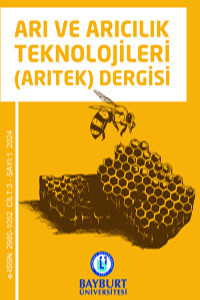Öz
Karl Von Frisch, (1886-1982) yılları arasında yaşamış Alman-Avusturya kökenli meşhur bir Hayvan bilimcidir. Hayvan davranışları alanında Karl Von Frisch, uzmanlaşmış ve yaşamını hayvan davranışlarını araştırmakla geçirmiştir.Böcek türleri üzerinde ve bilhassa da arılar üzerinde kayda değer araştırmalar yapmıştır.Yaşamının önemli bir kısmını arı davranışları ve özel olarak da arı davranışlardan biri ve en önemlisi olan “Kuyruk Sallama Dansı” (Waggle Dance) üzerine harcamıştır.
Bal arılarının haberleşme sisteminde bal arıları ‘’arı dansı’’ adı verilen özel bir yöntemden yararlanmaktadırlar. Dans hareketleri Avusturyalı bilim adamı Karl von Frisch tarafından keşfedilmiştir. Karl von Frisch bal arılarının kendilerine özgü bir dans kullanarak kovanda birbirlerine nasıl bilgi aktardıklarını çözmüştür (Frisch, 1993)
Bal arısı ( Apis ) dans iletişimi, hayvanlar arasında tartışmasız en çok övülenidir. Arılar, değerli kaynakların yerini yuva arkadaşlarına bildirmek için dans ederler ve danslar, bu kaynaklara ek toplayıcıların katılmasında etkilidir (Seeley, (1995))
Arılar ilginç bir haberleşme sistemi olarak dans ederler. İşçi arılar veya tarlacı arılarak olarak tanımlanan arılar besin kaynağı buldukları zaman kovana geldikleri zaman “arı dansı” (bee dance) adı verilen kendilerine özgü hareketlerle kaynağın yönünü, uzaklığını ve kaynağın miktarını kovan içinde bulunan diğer arılara öğretirler. Bu sayede arılar kovandan kilometrelerce uzaklıktaki besin kaynağını çok fazla zaman ve enerji harcamadan bulabilirler. (DODOLOĞLU, 2017)
Anahtar Kelimeler
bal arısı arı dansları yön bulma sallanma dansı dairesel dans
Kaynakça
- Beyaert, L. G. (2012). Honeybees consolidate navigation memory during sleep. . Journal of Experimental Biology,, 215(22), 3981-3988.
- DODOLOĞLU, A. &. (2017). ARICILIĞIN TEMEL ESASLARI. Atatürk Üniversite Ziraat Fakültesi Ofset Tesisi.
- Dyer, F. C. (2002). Dyer, F. C. (2002). The biology of the dance language. Annu. Rev. Entomol. 47, 917-949. The Biology of the Dance Language, 47, 917-949.
- Frisch, K. V. (1993). The dance language and orientation of bees. Harvard University Press.
- Liang, Z. S.-Z. (2012). Molecular determinants of scouting behavior in honey bees. 335(6073), 1225-1228.
- Michener, C. D. (1974). The social behavior of the bees: a comparative study. Harvard University Press.
- Seeley, T. D. ( (1995)). The Wisdom of the Hive. Cambridge: Harvard University Press.
- Srinivasan, M. V. (2000). Honeybee navigation: nature and calibration of the “odometer”. 287, 851-853.
- Teknik Arıcılık. (1986). Teknik Arıcılık, 8.
Öz
Karl Von Frisch is a famous animal scientist of German-Austrian origin who lived between (1886-1982). Karl Von Frisch specialized in the field of animal behavior and spent his life researching animal behavior. He carried out significant research on insect species, and especially on bees. He spent a significant part of his life on bee behavior and specifically on "Tail Wagging Dance", one of the most important bee behaviors. He spent it on (Waggle Dance). In the communication system of honey bees, honey bees use a special method called "bee dance". Dance movements were discovered by Austrian scientist Karl von Frisch. Karl von Frisch figured out how honeybees transfer information to each other in the hive by using a unique dance. Honeybee (Apis) dance communication is arguably the most celebrated among animals. Bees dance to communicate the location of valuable resources to their nestmates, and dances are effective in recruiting additional foragers to these resources. Bees dance as an interesting communication system. When worker bees or bees, defined as field bees, find a food source and come to the hive, they teach the direction, distance and amount of the source to the other bees in the hive with their unique movements called "bee dance". In this way, bees can find the food source kilometers away from the hive without wasting too much time and energy.
Anahtar Kelimeler
Kaynakça
- Beyaert, L. G. (2012). Honeybees consolidate navigation memory during sleep. . Journal of Experimental Biology,, 215(22), 3981-3988.
- DODOLOĞLU, A. &. (2017). ARICILIĞIN TEMEL ESASLARI. Atatürk Üniversite Ziraat Fakültesi Ofset Tesisi.
- Dyer, F. C. (2002). Dyer, F. C. (2002). The biology of the dance language. Annu. Rev. Entomol. 47, 917-949. The Biology of the Dance Language, 47, 917-949.
- Frisch, K. V. (1993). The dance language and orientation of bees. Harvard University Press.
- Liang, Z. S.-Z. (2012). Molecular determinants of scouting behavior in honey bees. 335(6073), 1225-1228.
- Michener, C. D. (1974). The social behavior of the bees: a comparative study. Harvard University Press.
- Seeley, T. D. ( (1995)). The Wisdom of the Hive. Cambridge: Harvard University Press.
- Srinivasan, M. V. (2000). Honeybee navigation: nature and calibration of the “odometer”. 287, 851-853.
- Teknik Arıcılık. (1986). Teknik Arıcılık, 8.
Ayrıntılar
| Birincil Dil | Türkçe |
|---|---|
| Konular | Bitki Bilimi (Diğer), Hayvan Bilimi (Diğer), Ziraat Mühendisliği (Diğer) |
| Bölüm | Derlemeler |
| Yazarlar | |
| Erken Görünüm Tarihi | 13 Haziran 2024 |
| Yayımlanma Tarihi | 27 Haziran 2024 |
| Gönderilme Tarihi | 26 Mart 2024 |
| Kabul Tarihi | 10 Haziran 2024 |
| Yayımlandığı Sayı | Yıl 2024 Cilt: 3 Sayı: 1 |


